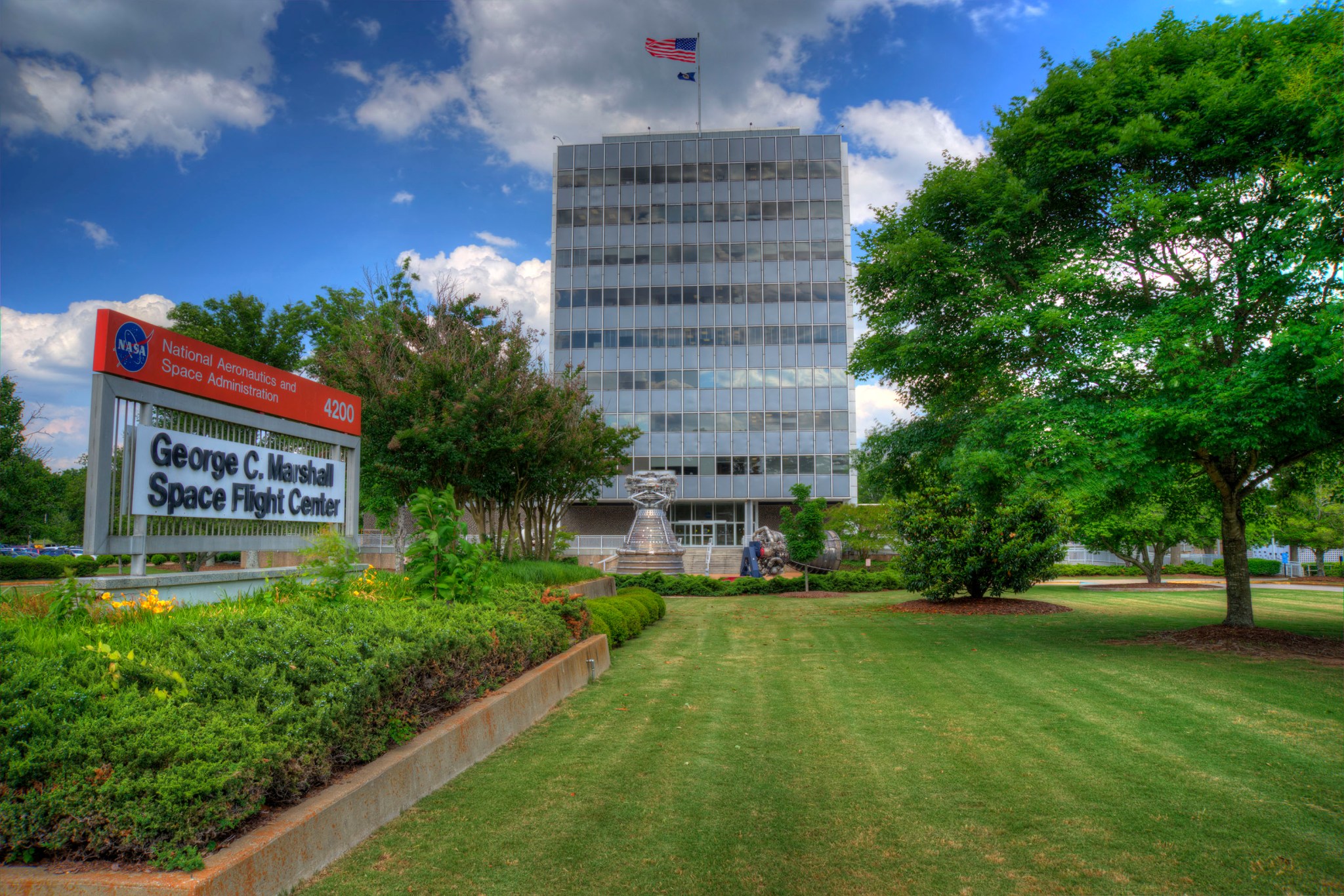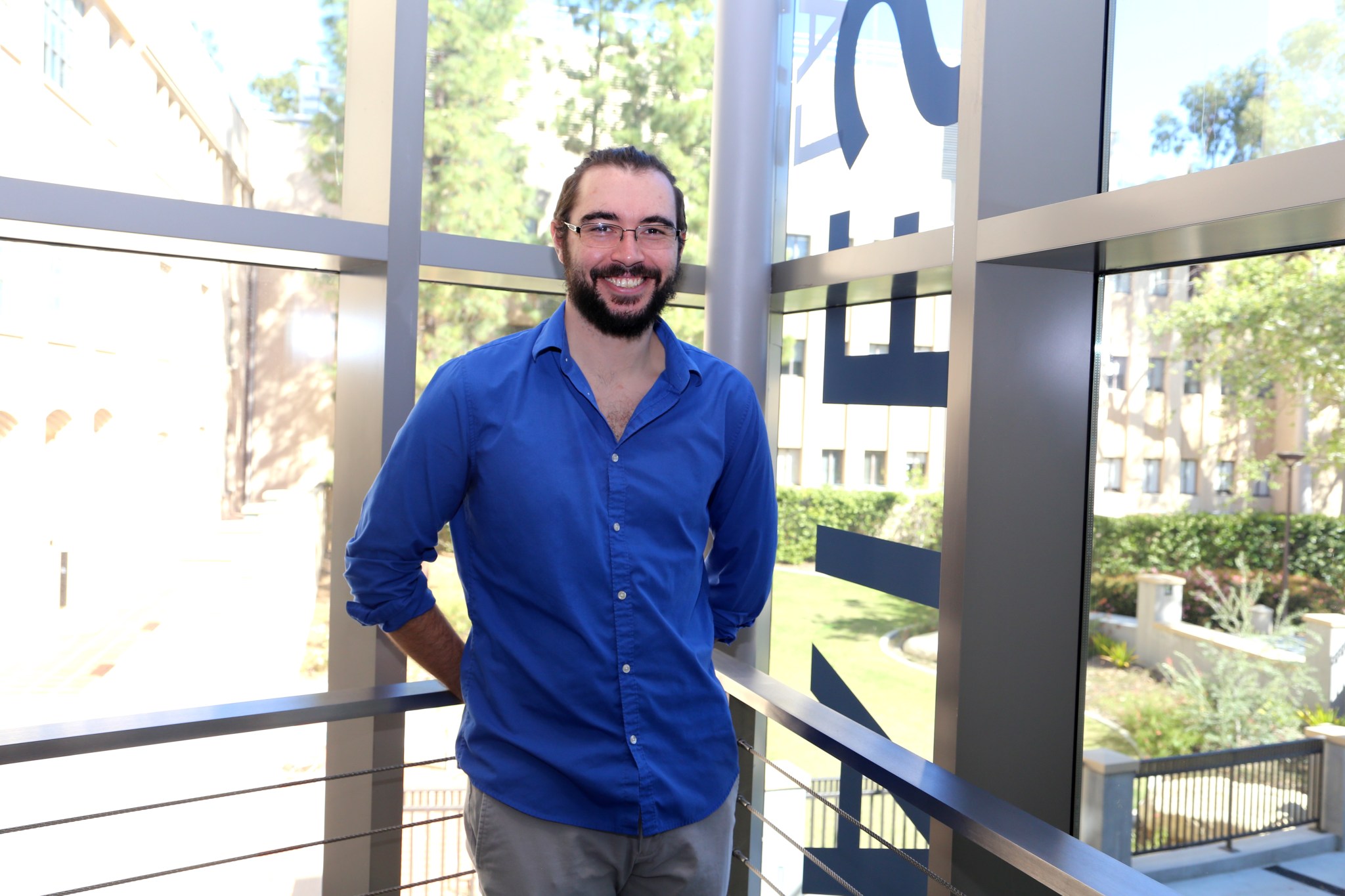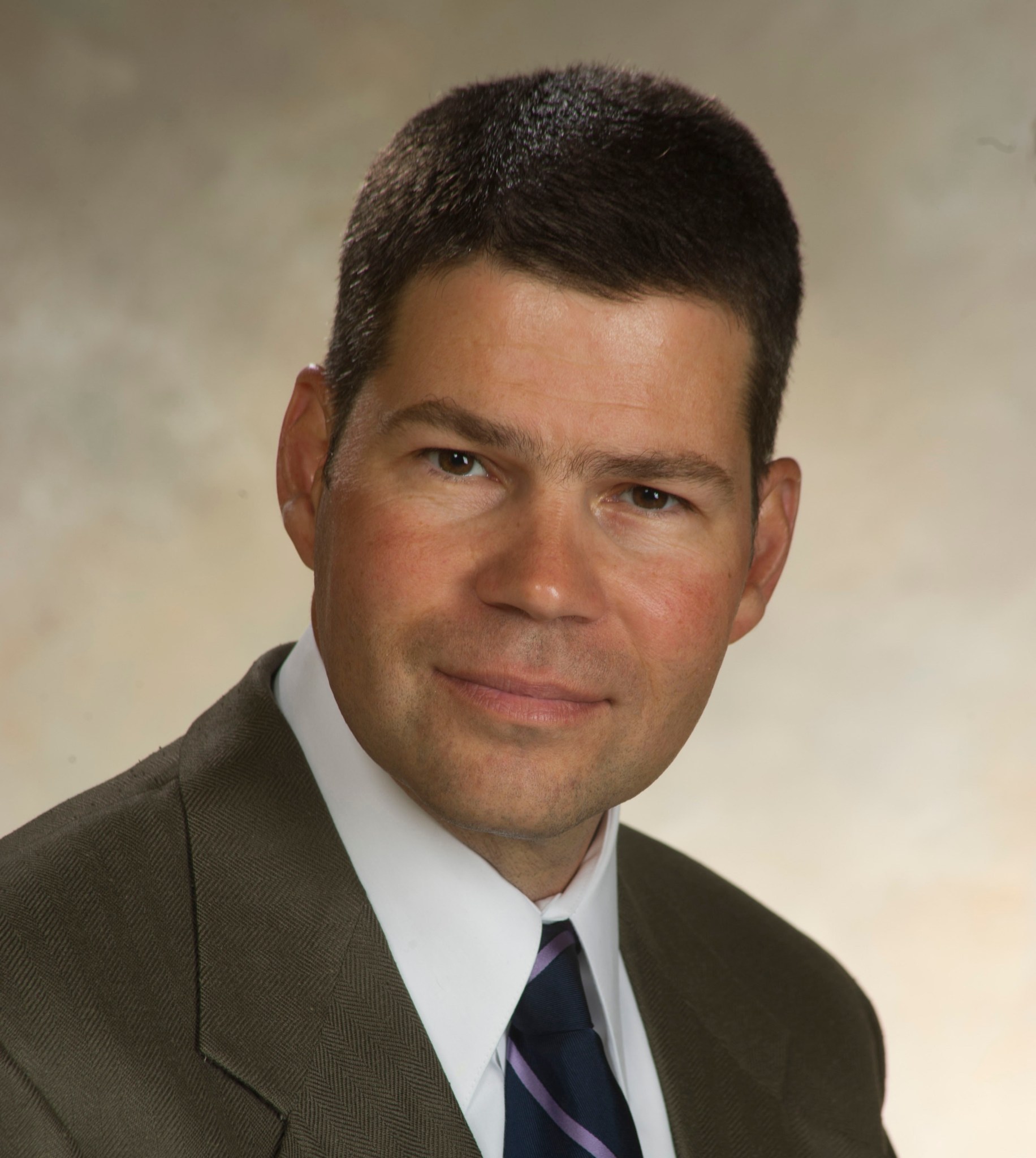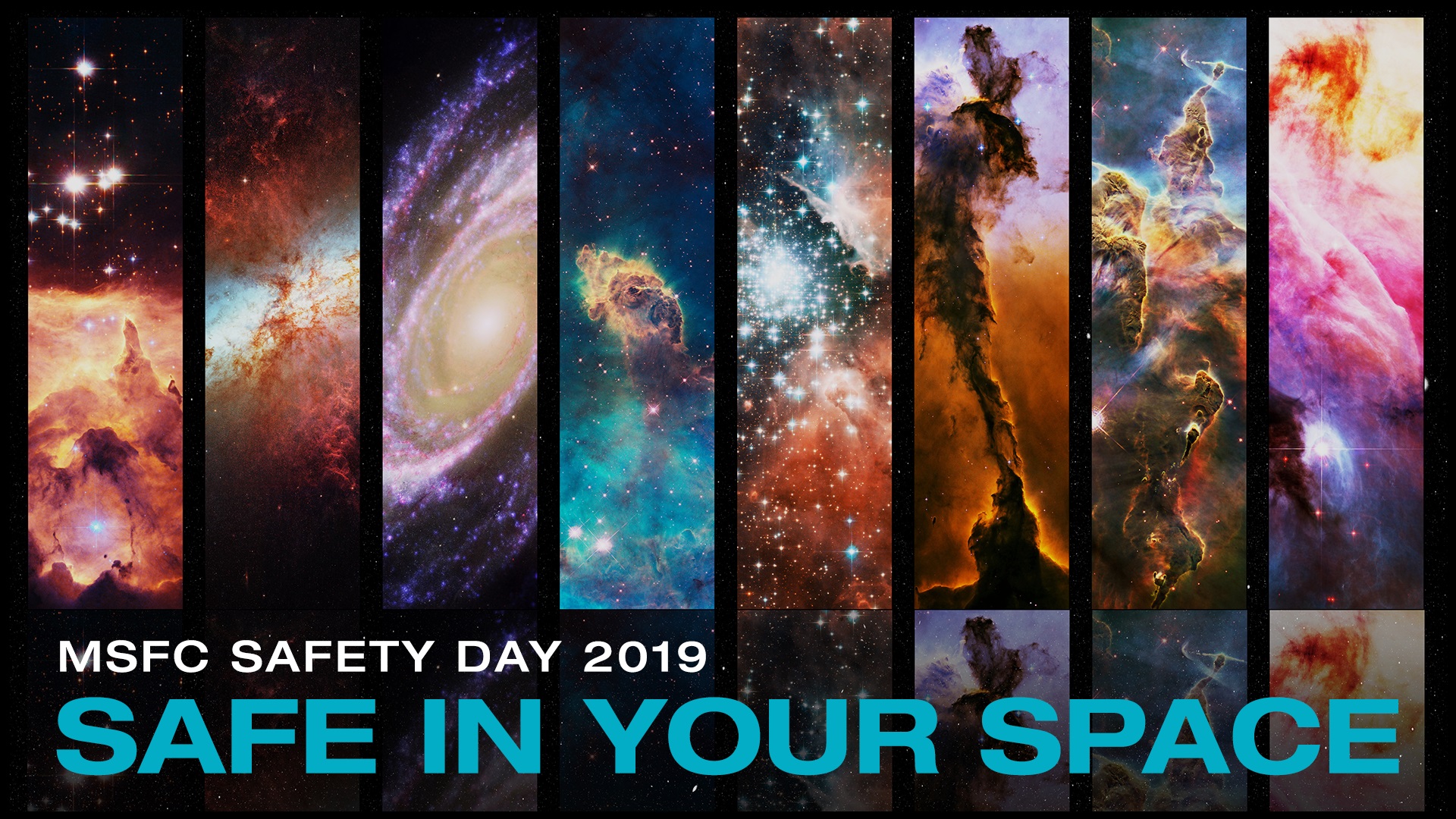In This Week’s Star
- NASA, Marshall to Recognize Team Members at Annual Honor Awards Ceremonies Sept. 25
- William Hill Named Director for Advanced Technology in Marshall’s Science and Technology Office
- John Blevins Named Space Launch System Program Chief Engineer
- Marshall Participates in 12th Annual Wernher von Braun Symposium
- Marshall to Hold Annual Safety Day Activities Oct. 2
- RSIC Online Registration Deadline is Sept. 20, Plans in Place to Move Journals After Library Closes
- Scientists Discover Black Hole Has Three Hot Meals a Day
- Astrobotic Mission Director Sharad Bhaskaran Delivers September Tech Talk
- National Weather Service Chiefs Visit NASA’s SPoRT Team at NSSTC
- This Week in NASA History: HEAO-3 launches – Sept. 20, 1979
NASA, Marshall to Recognize Team Members at Annual Honor Awards Ceremonies Sept. 25
By Taylor Goodwin
NASA and the agency’s Marshall Space Flight Center will recognize more than 300 Marshall employees, contractors and teams during the annual Honor Awards ceremonies Sept. 25 in Activities Building 4316. All Marshall team members are invited to attend.
Presentations will be made during two ceremonies: agency-level awards at 10 a.m. and center-level awards at 2 p.m. The morning ceremony will recognize those who have made significant achievements to NASA’s mission at an agency level. The afternoon ceremony will recognize those who have made outstanding mission contributions to Marshall.
Dennis Andrucyk, deputy associate administrator for NASA’s Science Mission Directorate, will be the keynote speaker at both ceremonies. Andrucyk and Marshall Director Jody Singer will present the awards to the honorees.
Announcing the agency-level awards will be Paul McConnaughey, deputy director of Marshall; Mary Beth Koelbl, deputy director of Marshall’s Engineering Directorate; and Angelia Walker, deputy director of Marshall’s Spacecraft and Vehicle Systems Department.
The center-level awards will be announced by Marcus Lea, director of Marshall’s Office of Human Resources; Julie Bassler, manager of Marshall’s Stages Office in the Space Launch System Program Office; and Jason Detko, director of Marshall’s Office of Procurement.
Neil Rodgers, director of Marshall’s Office of the Chief Information Officer, will emcee.
A reception will immediately follow both ceremonies.
For a list of the NASA Honor Awards, click here.
For a list of the Marshall Honor Awards, click here.
Goodwin, an ASRC Federal/Analytical Services employee, supports the Office of Strategic Analysis & Communications.
William Hill Named Director for Advanced Technology in Marshall’s Science and Technology Office
William Hill has accepted the position of director for advanced technology in the Science and Technology Office at NASA’s Marshall Space Flight Center. In his new role, Hill will provide expert advice and assistance to the Science and Technology Office manager in all facets of the organization’s responsibilities.
Most recently, Hill served as the deputy associate administrator for Exploration Systems Development at NASA Headquarters, where he provided executive leadership and program direction for development of the Space Launch System, Orion multi-purpose crew vehicle, exploration ground systems programs and overall systems integration. Prior to that, he was assistant associate administrator for space shuttle in the Space Operations Mission Directorate where he safely executed the last 21 space shuttle missions through the complete assembly of the International Space Station, as well as the final Hubble Space Telescope servicing mission.
Hill joined the Space Shuttle Office at Headquarters in 2002 as a senior integration manager. He led the post-Columbia return-to-flight activities, including directing the response and recovery activities and leading the preparation of NASA’s response to the Columbia Accident Investigation Board recommendations and findings. Prior to that, Hill served as the lead space shuttle operations safety manager in the Office of Safety and Mission Assurance, leading the agency’s space shuttle safety community in risk management activities and providing support and recommendations to the associate administrator for Safety and Mission Assurance regarding flight rationale.
Hill is the recipient of the Presidential Rank Award for Meritorious Service, a NASA Exceptional Service Medal, the Space Flight Awareness Silver Snoopy award and numerous other agency awards.
John Blevins Named Space Launch System Program Chief Engineer
John Blevins has been named chief engineer of the Space Launch System Program at NASA’s Marshall Space Flight Center. He succeeds Garry Lyles, who retired in August.
Prior to joining NASA in 1999, Blevins held industry positions at Honda of America Manufacturing Inc., Hewlett-Packard and Sverdrup Technology Group. Since joining NASA, he has held positions in the Combustion Devices Branch within the Propulsion Systems Department and served in various roles in the Spacecraft & Vehicles Systems Department, including team lead of Aerodynamics, branch chief of Aerosciences and technical assistant to the Structural Design and Analysis Division. Most recently, he has acted as the SLS deputy chief engineer and, since April 2017, manager of the SLS Engineers Office.
Blevins earned a bachelor’s degree in mechanical engineering from Tennessee Technological University in Cookeville, Tennessee, in May 1990. He earned a master’s degree in science in December 1993 and a doctorate in mechanical and aerospace engineering in December 1997, both from the University of Alabama in Huntsville.
Blevins is an associate fellow with the American Institute of Aeronautics and Astronautics and a licensed professional engineer. Additionally, he is an experienced pilot with airline transport and flight instructor ratings.
Marshall Participates in 12th Annual Wernher von Braun Symposium
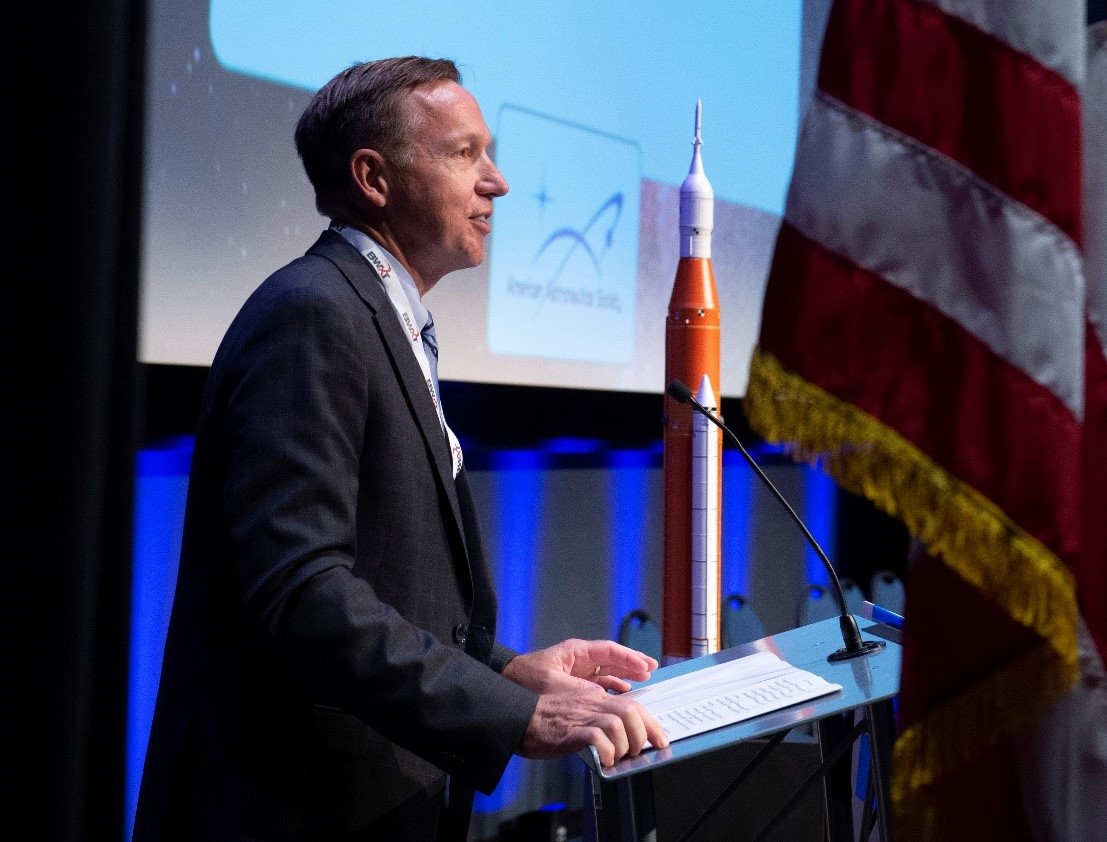
Steve Miley, associate director of NASA’s Marshall Space Flight Center, welcomes members of the aerospace community to the 12th annual Wernher von Braun Memorial Symposium on Sept. 10-12 at the University of Alabama in Huntsville. The symposium, hosted by the American Astronautical Society, featured speakers and panelists from government, industry and academia. This year’s symposium theme was “Exploration is the Work of Generations,” focusing on lunar lander technology, space policy, the Artemis program, propulsion systems and exploration technology. “What a fitting theme, since we just celebrated the 50th anniversary of Apollo 11 and the 20th anniversary of Chandra,” Miley said. “We want to keep the momentum of these celebrations going, and this event is a great way to do so as we advance our common goals of space exploration.” To see footage of the panel discussions, visit https://go.nasa.gov/2UX3QMA. (NASA/Emmett Given)
Marshall to Hold Annual Safety Day Activities Oct. 2
NASA’s Marshall Space Flight Center will hold its annual Safety Day activities Oct. 2 from 9:30 a.m. to 3 p.m. The theme for this year’s program is “Safe in Your Space.”
Gerry Schumann, NASA’s Mishap Investigation Program executive, will open the day’s activities with a keynote address on workplace and personal safety at 9:30 a.m. in Building 4200’s Morris Auditorium.
Schumann, a 40-year veteran of federal government safety programs, has supported more than 30 space shuttle launches and 33 shuttle landings as a Safety & Mission Assurance safety representative. Following the loss of space shuttle Columbia in 2003, he spent nearly four months in East Texas as lead safety representative and incident commander, for which he received NASA’s Exceptional Service Medal. After multiple hurricanes lashed Florida in 2004, he developed and led recovery plans for NASA’s Kennedy Space Center, for which he earned the agency’s Exceptional Achievement Medal. During his tenure, NASA’s injury and illness rates have been among the lowest in the federal government.
Other Safety Day activities include:
- A beginner’s yoga class from 10-11 a.m. in Building 4315’s Wellness Center.
- A vendor fair in Activities Building 4316 from 11 a.m. to 3 p.m. Vendors will include the Alabama Law Enforcement Agency, Nothing Bundt Cakes, Redstone Fire and Rescue, Redstone Harley Davidson, the Tennessee Valley Training Center, Therapy Partners, Therapy South, 3M Fall Protection and many others.
- Free food and beverages will be available during the vendor fair, on a first-come-first-served basis. Flu shots and other immunizations also will be available while supplies last.
- Incident and Injury-Free Workshops from noon to 3:30 p.m. in Building 4200, Room 228; Building 4221, Room 5106; and Building 4600, Room 2014.
- A safety-themed game of “Wheel of Fortune” at 1 p.m. in the Activities Building.
- A Zumba exercise class from 2-3 p.m. in the Wellness Center.
Visit the Safety, Health & Environmental Program page on ExplorNet for more information.
RSIC Online Registration Deadline is Sept. 20, Plans in Place to Move Journals After Library Closes
The Redstone Scientific Information Center will close its physical location Sept. 30, and begin operating exclusively as an online entity Oct. 1.
Civil servants and contractors at NASA’s Marshall Space Flight Center have until Sept. 20 to become a registered RSIC user, which allows access to RSIC’s online subscriptions through spring 2020. To register, civil servants can fill out the form found here and return it per instructions on the form. Contractors should send their completed form to Norma Horton.
Registered users can check out an unrestricted number of books until Sept. 29. Users can also check out some journals and reference materials. Team members who take a book, journal or reference material, must check them out through the RSIC librarian. Materials checked out become the property of the Marshall library, not of the employee.
Marshall is in the process of developing an on-site library.. The library team will provide updates as spaces for the new library are determined. Look for announcements in ExplorNet and through the library team’s email distribution list. To be added to the list, send your name and email to Mary Ellen Harris.
Employees can also attend a Town Hall informational meeting to learn more about the closing and progress on the Marshall library. These will be held from 11: 30 a.m. to 12:30 p.m. on the following days:
Thu., Sept. 19 – Building 4600, Room 2014
Mon., Sept. 23 – Building 4203, Room 1201
Tue., Sept. 24 – Building 4600, Room 1106
For more information, contact Ed Kiessling at 256-544-7421 or Jennifer Stevens at 256-544-5004.
Scientists Discover Black Hole Has Three Hot Meals a Day
There’s an adage that it’s not healthy to skip meals. Apparently, a supermassive black hole in the center of a galaxy millions of light years away has gotten the message.
A team of astronomers found X-ray bursts repeating about every nine hours originating from the center of a galaxy called GSN 069. Obtained with NASA’s Chandra X-ray Observatory — managed by NASA’s Marshall Space Flight Center — and the European Space Agency’s XMM-Newton, the data indicate that the supermassive black hole there is regularly consuming large amounts of material.
While scientists had previously found two “stellar mass” black holes — weighing about 10 times the Sun’s mass — occasionally undergoing regular outbursts before, this behavior has never been detected from a supermassive black hole until now.
The black hole at the center of GSN 069, some 250 million light years from Earth, contains about 400,000 times the mass of the Sun. The researchers estimate the black hole consumes about four Moon’s worth of material approximately three times a day. That’s equivalent to almost a million billion billion pounds per feeding.
“This black hole is on a meal plan like we’ve never seen before,” said Giovanni Miniutti from ESA’s Center for Astrobiology in Spain, the first author of a Nature paper published Sept. 11, which describes these results. “This behavior is so unprecedented we had to coin a new expression to describe it: X-ray Quasi-Periodic Eruptions.”
ESA’s XMM-Newton was the first to observe this phenomenon in GSN 069 with the detection of two bursts Dec. 24, 2018. Miniutti and colleagues then followed up with more XMM-Newton observations Jan. 16-17, and found five outbursts. Observations by Chandra on Feb. 14 revealed an additional three outbursts.
“By combining data from these two X-ray observatories, we have tracked these periodic outbursts for at least 54 days,” said co-author Richard Saxton of the European Space Astronomy Centre in Madrid, Spain. “This gives us a unique opportunity to witness the flow of matter into a supermassive black hole repeatedly speeding up and slowing down.”
During outbursts, the X-ray emission becomes about 20 times brighter than during quiet times. The temperature of gas falling toward the black hole also climbs, from about 1 million degrees Fahrenheit during the quiet periods to about 2.5 million degrees Fahrenheit during the outbursts. The temperature of the latter is similar to that of gas found around most actively growing supermassive black holes.
The origin of this hot gas has been a long-standing mystery. It appears to be too hot to be associated with the disk of in-falling matter surrounding the black holes. Although its origin is also a mystery in GSN 069, studying a supermassive black hole where hot gas repeatedly forms then disappears may provide important clues.
“We think the origin of the X-ray emission is a star that the black hole has partially or completely torn apart and is slowly consuming,” said co-author Margherita Giustini, also of ESA’s Center for Astrobiology. “But as for the repeating bursts, this is a completely different story whose origin needs to be studied with further data and new theoretical models.”
The consumption of gas from a disrupted star by a supermassive black hole has been observed before, but never accompanied by repetitive X-ray bursts. The Chandra data were crucial for this study because they pinpointed the X-ray source in the center of the host galaxy, where a supermassive black hole is expected to be. The data from Chandra and XMM-Newton implies that the size and duration of the black hole’s meals have decreased slightly, and the gap between meals has increased. Future observations will be crucial to see if the trend continues.
Along with data from Chandra and XMM-Newton, the international research team used data from NASA’s Swift Observatory, the NASA/ESA Hubble Space Telescope, the National Radio Astronomy Observatory’s Karl G. Jansky Very Large Array in New Mexico, the Commonwealth Scientific and Industrial Research Organization’s Australia Telescope Compact Array and the South African Radio Astronomy Observatory’s MeerKAT radio telescope.
The Smithsonian Astrophysical Observatory’s Chandra X-ray Center controls science and flight operations from Cambridge, Massachusetts.
Astrobotic Mission Director Sharad Bhaskaran Delivers September Tech Talk
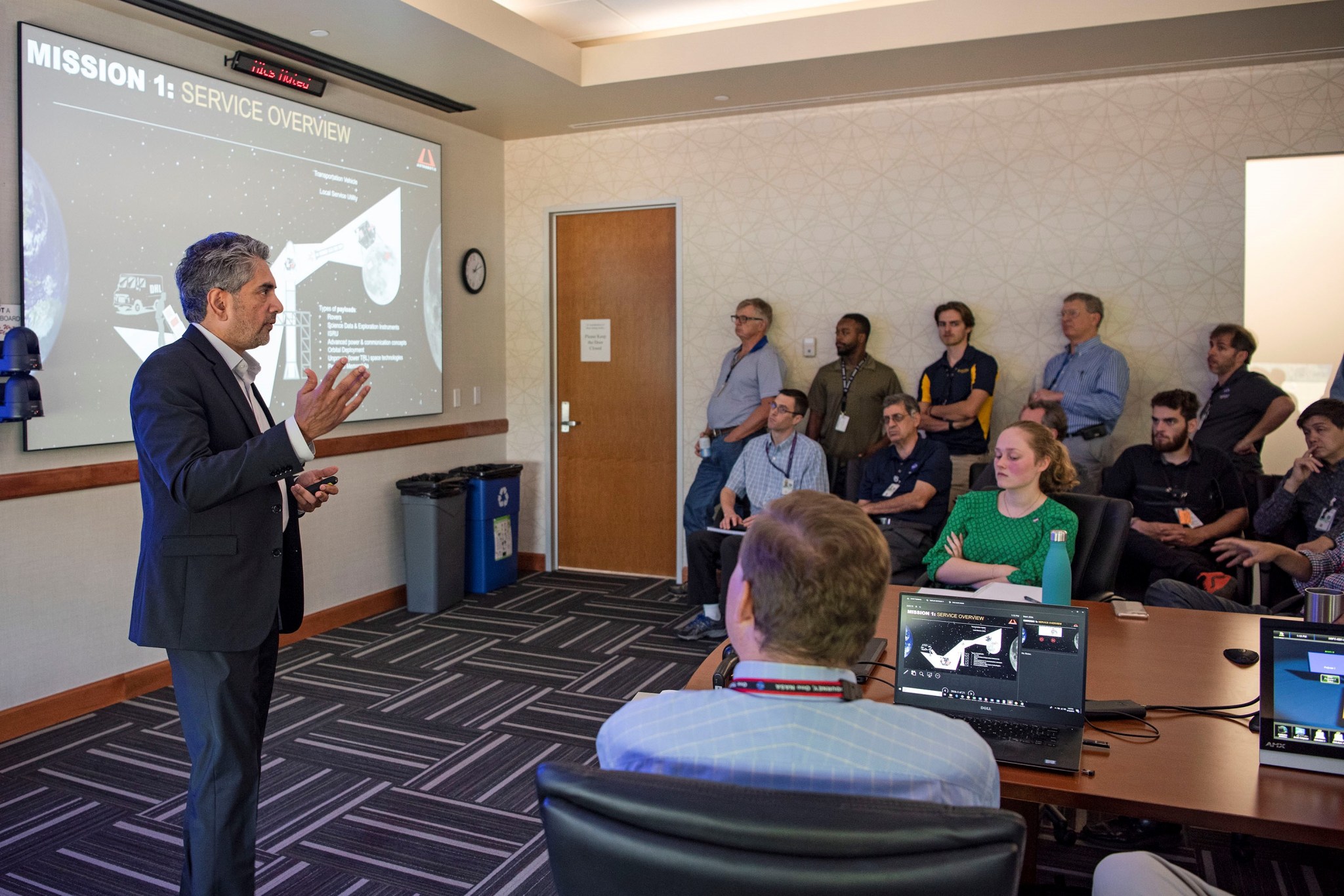
Sharad Bhaskaran, mission director for Pittsburgh-based Astrobotic, delivers the monthly Tech Talk on Sept. 12 in Building 4221 at NASA’s Marshall Space Flight Center. Bhaskaran presented Astrobotic’s Peregrine lunar lander which will deliver payloads to the surface of the Moon for government and commercial customers, including NASA. Astrobotic was selected by the agency as one of the companies for NASA’s Commercial Lunar Payload Service program. Peregrine is capable carrying new technologies to the Moon that are in the early stages of the development and maturation process, to test and give them flight experience which, in turn, can enable them to be used in more missions. The first mission of Peregrine is slated for 2021 and will focus primarily on safely landing on the Moon. Tech Talk is presented by the Marshall Center Chief Technologist’s Office. The next Tech Talk, scheduled for Oct. 17, will feature Steve Altemus of Intuitive Machines in Houston, who will speak about his company’s lunar lander. (NASA/Charles Beason)
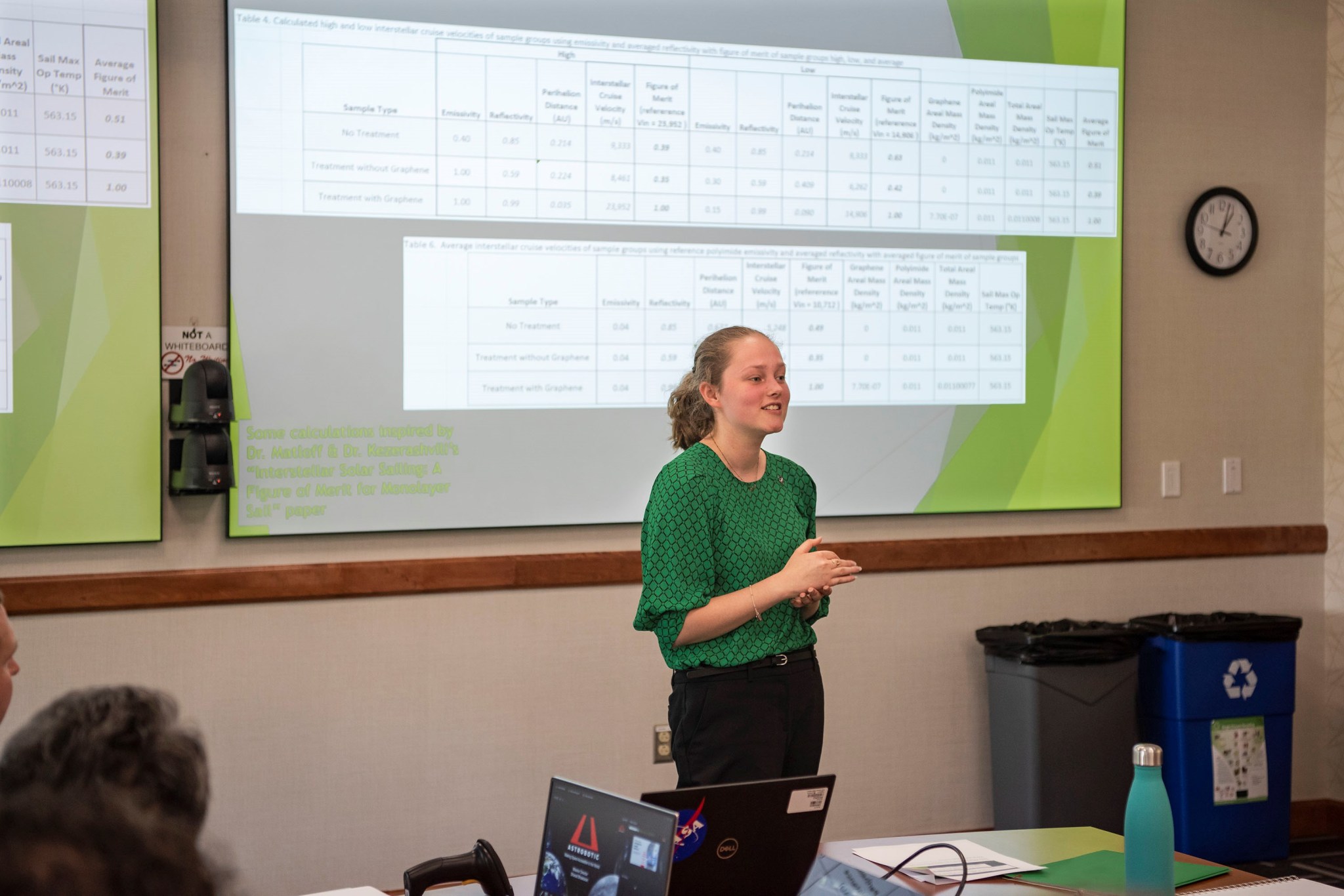
Prior to Bhaskaran’s talk, Morgan Barkhurst, a high school junior from Florida, presented her research into solar sails. Barkhurst was invited to speak as an opportunity to engage the next generation of scientists, engineers and technologists. Marshall, in conjunction with NASA’s Jet Propulsion Laboratory, developed a solar sail experiment called Near-Earth Asteroid Scout — NEA Scout — which will fly as one of 13 secondary payloads aboard NASA’s Space Launch System rocket on Artemis I. In addition to her high school classes, Barkhurst is dual-enrolled at Florida Gulf Coast University in Fort Myers. (NASA/Charles Beason)
National Weather Service Chiefs Visit NASA’s SPoRT Team at NSSTC
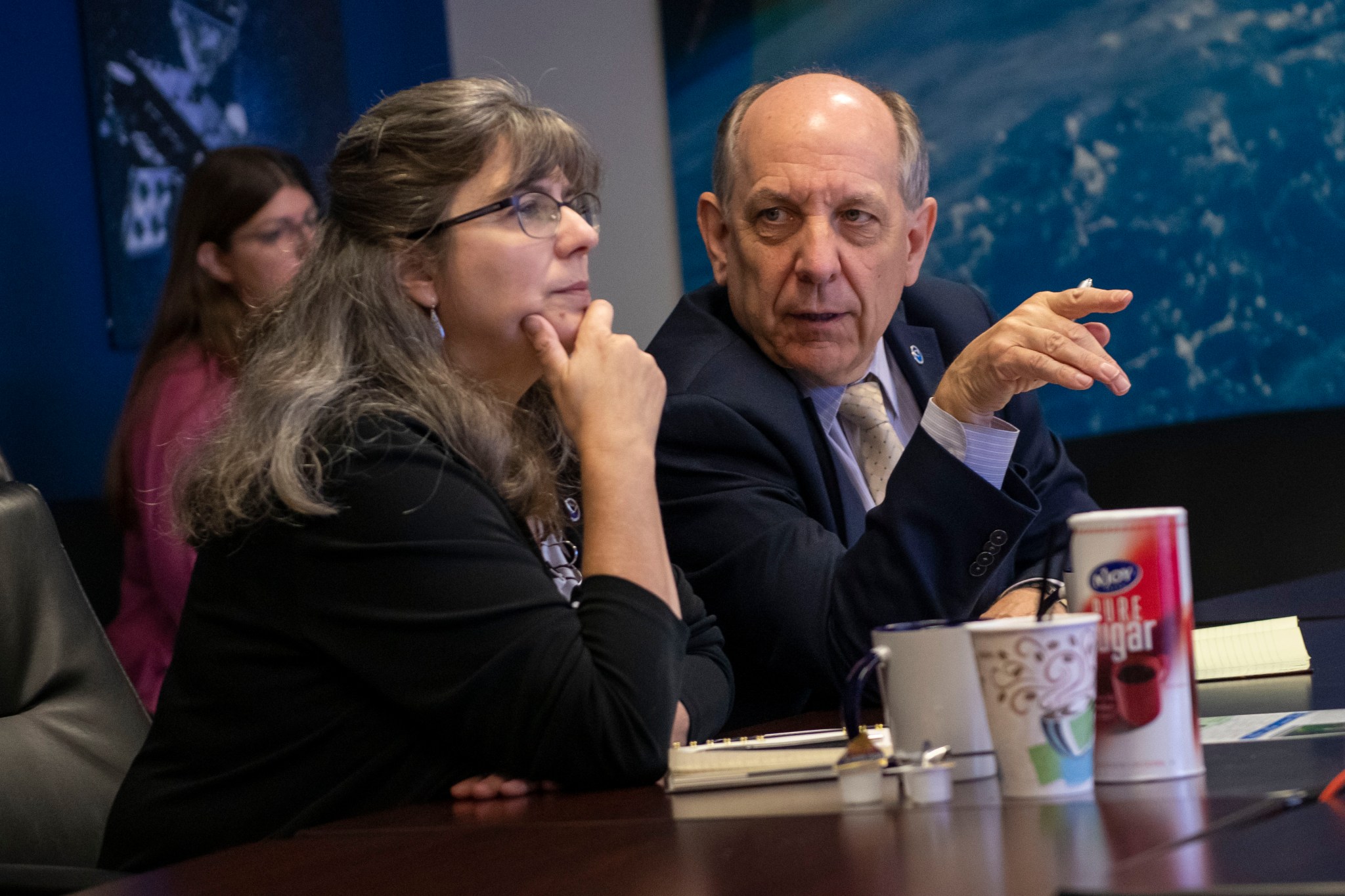
National Weather Service Director Louis Uccellini, right, and deputy director Mary Erickson hear from SPoRT team members during a visit Sept. 11 to the National Space Science and Technology Center in Huntsville. Managed by NASA’s Marshall Space Flight Center, the Short-term Prediction Research and Transition project transitions unique Earth observations and research capabilities to the operational weather community to improve short-term forecasts on a regional scale. (NASA/Fred Deaton)
This Week in NASA History: HEAO-3 launches – Sept. 20, 1979
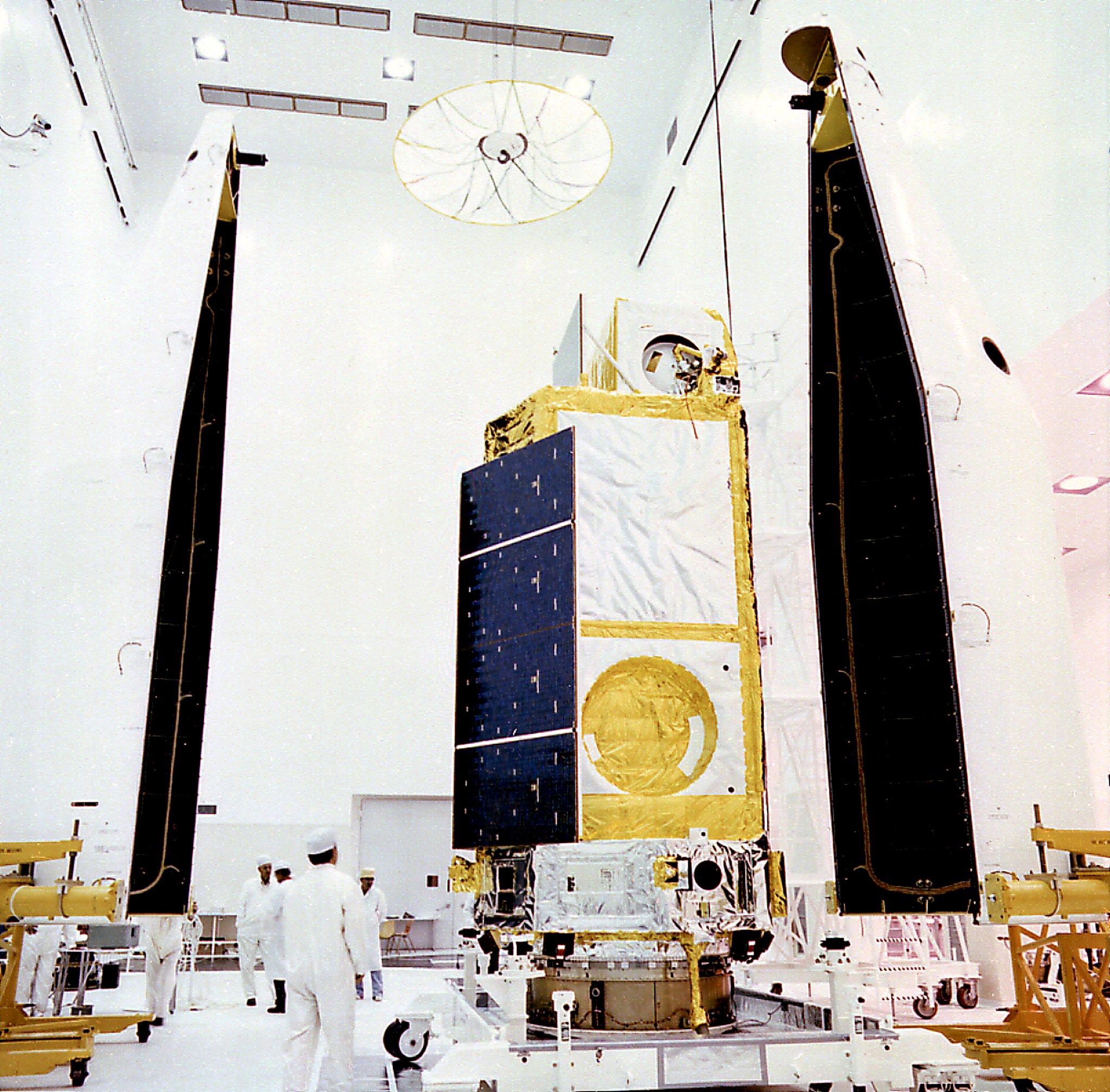
This week in 1979, the third and final High Energy Astronomy Observatory, HEAO-C, was launched from NASA’s Kennedy Space Center aboard an Atlas-Centaur rocket. Here, HEAO-C undergoes encapsulation. HEAO-C, known as HEAO-3 after insertion into orbit, continued the program’s mission of probing the electromagnetic spectrum, performing a sky survey of gamma rays and cosmic rays in a manner similar to HEAO-1. Together, the three HEAO missions propelled the emerging field of high energy astrophysics forward. Designed and developed by TRW Inc., the HEAO-3 project was managed by NASA’s Marshall Space Flight Center. The NASA History Program is responsible for generating, disseminating and preserving NASA’s remarkable history and providing a comprehensive understanding of the institutional, cultural, social, political, economic, technological and scientific aspects of NASA’s activities in aeronautics and space. For more pictures like this one and to connect to NASA’s history, visit the Marshall History Program’s webpage. (NASA)
























